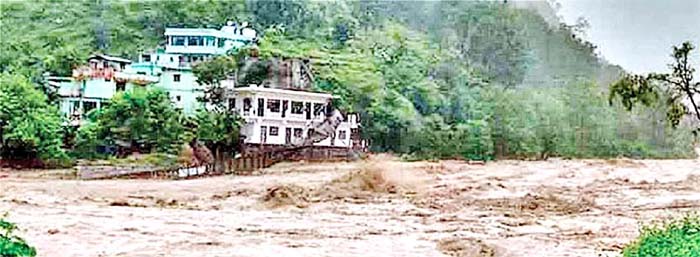- In the name of development, construction work and tampering with nature is going on continuously all over Uttarakhand
- Due to the massive deforestation, there is hardly any greenery left on the mountains
- It has become necessary to consider that the so-called development driven by human greed cannot be allowed to continue
ABHIMANYU JOON
The state of Uttarakhand has been in news consistently for tragic reasons since 2013, beginning with Kedarnath cloud burst to disastrous landslide in Chamoli. The state fondly addressed as ‘Land of Gods’ due to the presence of holy places for Hindus, Sikhs and Buddhists appears to be at the mercy of nature owing to catastrophic calamities happening one after another.
To explain in brief, Uttarakhand, which is situated at a crow-fly distance of 200 kilometers north-east of Delhi has an elevation varying from 300 to 7,600 meters above mean sea level, owing to its location between Shiwalik range to the south and the Great Himalayas to the north. This has led to the presence of three types of natural vegetation namely tropical moist deciduous, subtropical-temperate and alpine. With annual temperature range of 16 to 22 degree Celsius, the state has been a major tourist hub for the people residing in and around the National Capital Region (NCR). The inflow of tourists in 2019, including foreigners, was 37.58 million.
Tourism backbone of Uttarakhand
Tourism has emerged as the major source of revenue for Uttarakhand post implementation of favorable policies such as ‘home stays’ and provision of better facilities at religious sites en route the Kailash-Mansarovar trail. With 70% of the land covered by forest and 20% land being unproductive, livestock ranching and forestry are important means of livelihood. Close to 90% of the soil in the state is mountainous, which means it is silty and acidic in nature and needs to be kept covered with vegetation to be held in its place.
Indifferent govt, greedy business barons
The spate of lethal natural hazards occurring in the state can be attributed primarily to indifferent attitude of the state government in protecting the fragile terrestrial ecosystem and greed of profit-minded mineral extracting industries that have camped-in to exploit the underground resources. High grade limestone and gypsum are available in Almora, Bageshwar, Pithoragarh, Nainital, Pauri and Teri Gharwal districts of Uttarkhand, which are key raw materials in cement manufacturing. As a result well known companies such as Gammon India, Jaypee cement and Ambuja cement have established themselves at places like Roorkee in Haridwar district.
Circumventing judicial scrutiny
In order to circumvent judicial scrutiny over harm done to Uttarakhand’s unique environment and to subdue voices raised by local environmentalists, the state government declared limestone and gypsum as minor minerals and utilized its power under the Mines and Minerals [Development and Regulation] Amendment Act, 2015 to grant license for their mining in the state on a large scale. To justify this decision, it was declared that for ensuring rural electrification under schemes such as Deen Dayal Upadhyaya Gram Jyoti Yojna and subsequent socio-economic development, hydel power projects need to be constructed at 54 sites at an elevation of about 3,000 meters.
‘Char-Dham National Highway’ project spells disaster
Additionally, under the garb to improve road connectivity to the four holy shrines of Yamnotri, Gangotri, Badrinath and Kedarnath ‘Char-Dham National Highway’ development programme was launched in 2018 covering a length of 633 kilometers. This region falls under Bhagirathi eco-sensitive zone, by virtue of which no large scale construction can take place unless approved by an expert committee constituted to determine the level of loss to the fragile environment. On the contrary, hasty approvals were granted at departmental level leading to cutting down of nearly 40,000 trees just before the general elections of 2019.
Massive deforestation, blasting mountains weaken sedimentary rocks
The mammoth magnitude of construction initiated in higher reaches of Uttarakhand within the drainage basin of Alaknanda and its tributaries such as Mandakani, Dhauliganga and Pindar covering districts of Chamoli, Pithoragarh, Bageshwar, Rudraprayag and Pauri Garhwal led to massive deforestation, leaving the mountain slopes at an elevation of 4,500 to 5,000 metres with bare minimum vegetation. This decreased the cohesive force between soil particles and exposed them to harsh weather conditions. Moreover use of explosives to blast through mountains for construction of tunnels and approach roads further weakened the sedimentary rocks, which form the lithosphere in the region.
Centre for Science and Environment study bares all
As a result, under the effect of south-west monsoon experienced from July to September the weakened soil and rocks failed to hold on to steep slopes. They got saturated due to rain drops and experienced liquefaction, leading to sudden and unpredictable landslides all across the region. The problem got further exacerbated due to forest fires in the state as the ash left behind burnt forest made the soil unfit for vegetative growth. In the opinion of Delhi-based Centre for Science and Environment, forest fires in Kumaon Himalayas is not a naturally occurring phenomenon because the characteristics of trees is such they remain evergreen, meaning all the trees never shed their leaves at the same time unlike in the deciduous forests of central and western India. Also an important aspect is the average temperature at locations where forest fires have been experienced, despite experiencing change in climate remains around 38 degree Celsius even during summers.
Forest fires catalyse the melting of glaciers
According to Govind Ballabh Pant Institute of Himalayan Environment & Development, forest fires have catalysed the melting of glaciers in Uttarakhand by enabling deposition of Black Carbon that reduces albedo, the tendency of ice to reflect sunlight. Black Carbon also tends to locally raise the temperature by absorbing incoming solar radiation. The irony is Uttarakhand government secured a grant worth Rs 600 crore from the World Bank, for researching the cause of forest fires. The same government has made the state’s forest department handicap by keeping it understaffed and ill-equipped to deal with such a tragedy.
Human rights and environment are entwined: SC
To sum up the massive loss of life, property in Uttarkhand and consequent dent on its image of being a tourist friendly state is attributed to deliberate ignorance and lack of will of the state’s political and bureaucratic executives, in preventing disproportionate mining, unplanned construction that led to mass deforestation, which reduced the natural protection of mountains, culminating into deadly landslides. The need of the hour is that Uttarakhand government should display the moral courage to accept its failure in protecting fundamental rights granted under Article 21 of the Constitution, which as per the Supreme Court’s interpretation mentions that human rights and environment are entwined. Right to life cannot be enjoyed without a safe, clean and healthy environment.
Implement National Green Tribunal recommendations
It must try to undo all the wrong decisions and can begin with halting all the ongoing construction activity concerning mega hydel power plants being made on headstreams and tributaries of the Ganga. The dams which have been made should be converted to rain water harvesting structures that could be utilized to collect rapidly flowing rain water down the steep slopes of Kumaon Himalayas, leading to creation of several fresh water lakes thereby reducing intensity of flash floods. The water so collected could be utilized for fulfilling domestic needs of rural and urban population, which is facing water crisis owing to reduction in annual precipitation to the tune of 13.5 centimeter in last 25 years, as recorded by Indian Metrological Organisation. Secondly, the recommendations of National Green Tribunal based on report of Central Pollution Control Board on regulating mining in Uttarakhand should be implemented without any compromise.
Large scale reforestation need of the hour
Lastly, large scale reforestation on war footing should be carried out with cooperation of Ecological battalions of Territorial Army, whose technical expertise can be put to use for environmental restoration. Additionally, Dehradun-based Indian Council of Forestry Research and Education should be allowed to collaborate at the level of gram panchayats to ensure protection of planted saplings, so they are able to grow into trees in an unhindered manner. Some of the suitable varieties of trees for the temperate climate of Uttarkhand are Hybrid Polar, River Birch, Oak and Red Maple. These trees can grow at the rate of 3 to 5 feet a year if planted in scientifically correct manner. Chir and Cedar tree saplings should be avoided as they are prone to illegal felling due to their usage in construction and furniture making. Moreover Chir and Cedar secrete a sticky resin which is inflammable and these trees are known to reduce water retaining capacity of soil.
Set up waste-to-energy plants
The question to suffice power generation requirement can be addressed by adopting a decentralized approach. Rural and Urban local governments should be incentivized to identify such locations over which afforestation could not be successful but sheltering of soil needs to be done. At such spots solar trees with 11.5 KW capacity can be installed. These trees have been domestically developed by Council of Scientific and Industrial Research’s Central Mechanical Engineering Research Institute [CSIR-CMERI] and can be customized for diverse sites. In unison with this, waste-to-energy plants can be established that generate electricity utilizing solid waste. According to State of Environment Report released by Uttarkhand Environment Protection and Pollution Control Board, the state generates 900 metric tones of solid waste daily but is worst at its management since it processes 0% of it.
The Central government can play an active role by providing special grant to Uttarakhand under PM-KUSUM scheme and MGNREGA, which could be utilized for installing solar trees and creation of waste-to-energy generation cum processing plants.
It is high time for the present government of Uttarakhand by taking corrective action and prove that it functions by the democratic principle of ‘government by the people, for the people’. It should not be hampered in performance of its duty towards its citizens by the amount of royalty received from mineral extracting companies but should be concerned about the large scale loss of invested capital due to human induced calamities such as increase in landslide prone zones and rising intensity of wild fires. It needs to act right now, so as to prevent the high cost of resettling homeless people, who would not be able to live in the state any longer, owing to high risk of natural hazards.
The author of this article, Abhimanyu Joon, is a Design Engineer and freelance writer










